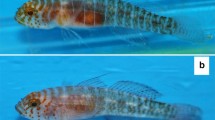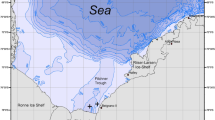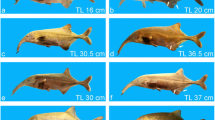Abstract
The spawing behavior ofHexagrammos otakii. H. octogrammus andH. agrammus was observed in two different regions of northern Japan using underwater video cameras placed near nests guarded by males. The spawning behavior of the three species consisted of similar patterns, although body size and nuptial coloration and nest location of territorial maleH. otakii differed from those of the other twoHexagrammos species. The courtship display of territorial males in each species involved rushing, butting and undulation of the trunk. When a female entered the nest, the male leaned his head on the future spawning bed in the nest and spasmodically undulated his trunk. The female that responded to the courtship laid her eggs within the seaweed bed. The territorial male then passed over the eggs, touching his genital pore to the egg mass, and released sperm. Sneaking by other males was frequently observed following the sperm emission. In both regions, females ofH. octogrammus andH. agrammus commonly responded to courtship of maleH. otakii and mated with them, but not vice versa. Possble reasons for the natural occurrence of such unidirectional hybridization are discussed.
Similar content being viewed by others
Literature Cited
Arnold, M. L. 1997. Natural hybridization and evolution. Oxford Univ. Press, New York, 215 pp.
Balanov, A. A. and D. V. Antonenko. 1999. First finding ofHexagrammos agrammus x H. octogrammus (Hexagrammidae) in Peter the Great Bay (the Sea of Japan). J. Ichthyol., 39: 149–156.
Bateman, P., 1983. Mate choice. Cambridge Univ. Press, Cambridge, 462 pp.
Crow, K. D., D. A. Powers and G. Bernardi. 1997. Evidence for multiple maternal contributors in nests of kelp greenling (Hexagrammos decagrammus, Hexagrammidae). Copeia, 1997: 9–15.
DeMartini, E. E. 1986. Reproductive colorations, paternal behavior and egg masses of kelp greenling,Hexagrammos decagrammus, and white spotted greenling,H. stelleri. Northwest Sci., 60: 32–35.
DeMartini, E. E., 1987. Paternal defence, cannibalism and polygamy: factors influencing the reproductive success of painted greenling (Pisces, Hexagrammidae). Anim. Behav., 35: 1145–1158.
Gomelyuk, V. E. 1988. Spawning behavior of Asian greenling,Pleurogrammus azonua, in Peter the Great Gulf. J. Ichthyol., 28: 82–90.
Gorbunova, N. N. 1970. Spawning and development of greenlings (family Hexagramidae). Pages 121–185in T.S. Rass, ed. Greenlings. (Translated from Russian by M. Raveh, Israel Program for Scientific Translations 1964).
Hubbs, C. L. 1955. Hybridization between fish species in nature. Syst. Zool., 4: 1–20.
Kanamoto, Z. 1998. The first record of masked greenling,Hexagrammos octogrammus, and rock greenling,H. lagocephalus, (Hexagrammidae) from Otsuchi Bay, Iwate Prefecture, Japan and remarks on the distributions of greenlings, Otsuchi Mar. Res. Cent Rep., 23: 12–21, (In Japanese.)
Karino, K. 1996. Sexual selection in fishes. Pages 78–133in T. Kuwamura and Y. Nakashima, eds. Reproductive strategies in fishes. Kaiyusha. Tokyo. (In Japanese.)
Munehara, H. and T. Miura. 1995. Non-intentional filial egg cannialism by the guarding male ofHexagrammos otakii (Pisces: Hexagramidae). J. Ethol., 13: 191–193.
Munehara, H., K. Shimazaki and S. Mishima. 1987. The process of oogenesis in masked greenling,Hexagrammos octogrammus. Bull. Fac. Fish. Hokkaido Univ., 38: 27–33.
Ohshima, Y. and N. Nakamura. 1944. The life history of fat greenling (Hexagrammos otakii Jordan et Starks). Nippon Suisan Gakkahshi, 9: 81–89. (In Japanese).
Quast, J. C. 1964. Meristic variation in the hexagrammid fishes. Fish. Bull., 63: 589–609.
Rohwer, S. 1978. Parental cannibalism of offspring and egg raiding as a courtship strategy. Am. Nat., 112: 429–440.
Rutenberg, E. P. 1970. Survey of the fishes of family Hexagrammidae. Pages 1–103in T. S. Rass. ed. Greenlings. (Translated from Russian by M. Raveh. Israel Program for Scientific Translations 1964).
Sakai, H. 1987. Population genetics of hybridization in the genusTribolodon, Cyprindidae. Pages 18–30in N. Mizuno and A. Goto, eds., The Freshwater Fishes of Japan. Tokai Univ. Press, Tokyo. (In Japanese.)
Shinohara, G. 1994. Comparative morphology and phylogeny of the suborder Hexagrammoidei and related taxa (Pisces: Scorpaeniformes). Mem. Fac. Fish. Hokkaido Univ., 41: 1–97.
Suzuki, K. and S. Hioki. 1975. Reproductive behavior of the greenling,Pleurogrammus azonus, observed in the aquarium. J. Japan. Assoc. of Zoological Garden and Aquarium, 17:92–97. (In Japanese.)
Wilby, G. B. 1937. The ling cod,Ophiodon elongatus girard. Bull. Biol. Board Can., 54: 1–24.
Wirtz, P. 1999. Mother species-father species: unidirectional hybridization in animals with female choice. Anim. Behav., 58: 1–12.
Yamamoto, G. and C. Nishioka, 1948. Breeding habits and developmental processes of greenling,Hexagrammos otakii Jordan et Starks. Scibutu, 3: 167–170. (In Japanese with English resume.).
Author information
Authors and Affiliations
About this article
Cite this article
Munehara, H., Kanamoto, Z. & Miura, T. Spawning behavior and interspecific breeding in three japanese greenlings (hexagrammidae). Ichthyological Research 47, 287–292 (2000). https://doi.org/10.1007/BF02674252
Received:
Revised:
Accepted:
Published:
Issue Date:
DOI: https://doi.org/10.1007/BF02674252




